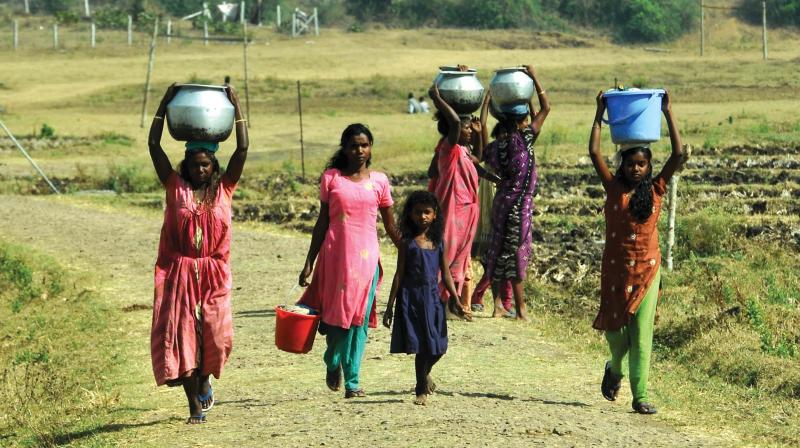Kabani river is now a bed of rocks
People living on the banks are worst hit, forced to dig ponds for drinking water.

KOLAVALLY (WAYANAD): For the second time in its history, river Kabani has been reduced to a bed of rocks and sand. The people who live on its banks in Karnataka and Kerala are digging ponds in the river to get water. In many villages, check dams were constructed to collect the water trickling down. It may be recalled that the river, the lifeline of the agrarian communities living on its banks in two states, had dried up in 2004 when the entire region faced acute water crisis and a devastating drought. A tributary of Cauvery, the river watered the parched lands of Karnataka and Tamil Nadu . Realising the importance of the river, the Karnataka government constructed the Kabani reservoir at Beechanahalli to ensure the maximum utilisation of the river water.
When the river had its full flow in monsoon, the heads of various farming clans in Karnataka used to visit the river and worship it with various rituals. After the construction of the Beechanahalli dam, the Karnataka chief minister visited the dam at the peak of monsoon to lead the rituals. But gone are those days. The local people say that during the last few years the river had its full flow only on rare occasions. Krishnan Kaitharam, a local farmer, told DC that the drying up of rivulets and minor tributaries had affected the river. “The deforestation in the catchment area of the river, farmers turning to pepper as mono crop, cutting down trees, planting plants like teak and shortage of rain have also resulted in recurring droughts”, he added.
The scene at Kolavally, the last village in Kerala from where the river enters Karnataka, is heart-rending. The tribal population residing in the Kolavallikadavu tribal settlement depends on the stream for everything. Geetha, a tribal woman of the colony, told DC that all the wells on the banks had dried up. “In the past, even during the hottest summer, we had drinking water in our wells. But now we are collecting water digging ponds on its banks,” she said. When the DC team met Geetha, she and a group of women were carrying water on their heads from the river to the settlement.
“We don’t know when we will be hit by water- born diseases”, she said and added that they were collecting water from the river in which people now wash clothes and animals and take bath. Countless wild animals also depend on the river to quench their thirst. Though the district administration has been supplying water to the settlements, those on the banks are yet to benefit. "There are 50 families in our settlement. If the district administration supplies at least 2000 litres of water, we could meet our drinking and cooking needs,” she added.
‘Greedy approach to nature costs’
The rejuvenation of Kabani means rejuvenating the entire ecology of the region. The death of the river indicates all- round ecological degradation, according to scientists and farmers. Mr Aneesh Nair, a local farmer, says that this barren river is the result of human folly. “We have constructed 55 check-dams in the tributaries of river Kabani in Pulppalli-Mullankolly panchayats after the severe drought in 2004. But almost all of them have been abandoned. Some even took away the wooden sheet used to block the water flow,” he said. “We do not learn from the past,” he pointed out.
Noted scientist Dr N. Anilkumar, head of MS Swaminathan Research Foundation, told DC that there is no inflow of water to the river. All the tributaries have dried up and the entire topography has changed. The reclamation of paddy fields for other purposes like banana farms had drained up the water reservoir of Kabani basin. “We have to change our land use system based on landscape management. The profit-oriented approach to farming should change. Nature has taught us that in the long run such greedy approach would rob us of everything, ” he said and added that the local bodies should focus more on practical water conservation methods. "Wayanad is a sloppy land. So we should not allow rain water to run out,” he added.
Greens also pointed out that the teak plantations of the forest department also contributed to the ecological disaster. The leaf of teak has high silica content. When the leaves fall, it would alter the chemistry of earth, reducing the eater retention capacity, said Mr N. Badusha, leader of Wayanad Prakrithi Samrakshana Samithy. “The heat would be higher in teak plantations as they monopolise the soil, killing the biodiversity,” he added. “The indigenous forests would be evergreen and water- rich while the alien species would drain out the water”, he said.

